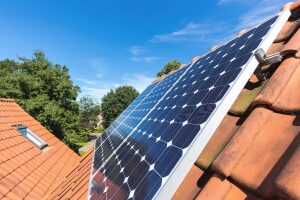Rethinking Export Tariffs: A Step Towards Fair Compensation for Domestic Solar Energy Producers
In the contemporary landscape of energy production, one of the most pressing questions is whether it's time to start paying realistic rates for outgoing tariffs from domestic solar systems to homeowners. Currently, the rates offered under export tariffs by electricity providers per kilowatt-hour (kWh) are widely perceived as inadequate, especially when compared to the rates consumers pay for electricity. This discrepancy not only raises questions about fairness but also about the broader implications for renewable energy adoption.
The core of the issue lies in the compensation rates for solar energy fed back into the grid from domestic systems. Homeowners with solar panels often generate more electricity than they consume, especially during peak sunlight hours. This excess energy is exported back to the grid, for which homeowners receive a tariff per kWh.
Currently, UK homeowners receive roughly 3-15 pence per kWh exported back to the grid – a far cry from the average 30 pence their neighbours pay for imported electricity. This discrepancy stems from the Smart Export Guarantee (SEG), a government initiative replacing the Feed-in Tariffs (FiTs). Proponents of the SEG argue it reflects wholesale market prices and encourages competition among energy providers. Critics, however, feel it undervalues homegrown solar and discourages potential adopters.
This stark contrast between export and import tariffs not only feels unjust but also undercuts the economic incentive for investing in solar technology.
The argument for increasing these tariffs is twofold. Firstly, it is a matter of fairness. Energy produced by homeowners is no less valuable than that generated by large-scale power plants. It seems only reasonable that the compensation for electricity fed into the grid should be closer to its market value. Fair compensation would acknowledge the investment homeowners have made in solar panels and their contribution to the energy grid.
Secondly, and perhaps more importantly, adjusting tariffs to more realistic levels could significantly boost the adoption of renewable energy technologies. The initial cost of installing solar panels is a significant barrier for many homeowners. While the long-term savings on energy bills and existing incentives are persuasive, better compensation for exported energy could be the tipping point for many potential adopters. With increased tariffs, the return on investment would become more attractive, shortening the payback period and making solar panels a more viable option for a broader segment of the population.
Incentivising domestic solar energy aligns with broader environmental goals. As countries strive to reduce carbon emissions and transition to renewable energy sources, encouraging solar panel installation is an easy step in the right direction. By making solar energy financially appealing to homeowners, we can accelerate the shift towards a greener, more sustainable energy grid.
Critics of increasing export tariffs argue that higher rates could lead to increased electricity prices for all consumers, as utility companies might pass on the cost to their customers. This concern is valid and underscores the need for a balanced approach. Any adjustment to tariffs must be carefully considered, ensuring that the benefits to solar producers do not unfairly burden those without solar panels.
The disparity between what homeowners receive for exporting solar energy and what their neighbours pay for grid electricity warrants a reevaluation of current tariff rates. Addressing the imbalance through fairer export tariffs is not just about economics; it's about acknowledging the environmental and societal value of this nascent power source.
By offering more realistic compensation, we can not only ensure fairness but also encourage wider adoption of solar technology. This shift could play a crucial role in meeting environmental targets and transitioning to a more sustainable energy future. However, it's imperative that this is done in a way that balances the interests of all stakeholders, including those without solar panels, to avoid unintended negative consequences.
Pre-order: The Ultimate Guide to Heat Pumps
Subscribe and follow our Homeowners’ Q&A heat pump podcast
‘Exports’ could and might well include previously imported grid energy stored in a battery until a more favourable time when export rates are an incentive. With tariffs such as ‘Agile’ from Octopus Energy, one might well find times when there is at least 15 pence per kW/h differential or ‘incentive’ to export and though this might not be as lucrative as OE’s ‘Saving Sessions’ might be where there is a peak demand period of perhaps an hour paying over £2 per kW/h, nevertheless playing the energy market could be very profitable - but is it ethical?
Of course, ‘Saving Sessions’ are employed to even out demand so personally, I think exporting previously ‘downloaded energy’ from my battery during a period of peak demand in an attempt to prevent peaker stations from being started up is a good thing all round.
I suppose campaigning for higher export tariffs and at the same time, lower import tariffs could be good for our bank accounts. Investment in all the equipment required is expensive I know - but would this mean those without the means having to pay more - or energy companies hitting the wall? Regards, Toodles.
Toodles, he heats his home with cold draughts and cooks his food with magnets.
the most obvious way would be a rate that equalled wholesale rates less a modest margin? Based on Octopus Tracker import rates that would probably be around 15p currently
The energy companies then could offer fixed rates (like Octopus Fixed 15p) or a variable rate that would have swings and roundabouts..
Listed Grade 2 building with large modern extension.
LG Therma V 16kw ASHP
Underfloor heating + Rads
8kw pv solar
3 x 8.2kw GivEnergy batteries
1 x GivEnergy Gen1 hybrid 5.0kw inverter
Manual changeover EPS
MG4 EV
I'm in Italy and we are paid the monthly average wholesale rate (publicly available from www.mercatoelettrico.org) for solar sent to the grid. My payments are made once a year, albeit a little late in the following June. I'm able to track my sent-to-grid data and work out reasonable accurately what the payment will be, minus a small administration fee (currently ca. 40 euro). In 2022 I sent 3340 kWh back to the grid and was paid 1136 euro in June 2023, since the wholesale rate was so high; for 2023, I sent 2790 kWh back and expect a payment of ca. 350 euros. Its all very simple imho.
Incidentally, for electricity taken from the grid I pay the monthly average wholesale rate to my supplier, plus taxes and fees etc which roughly ends up being (wholesale cost x 2) on the bill; so I'm roughly paid 50% of the bill cost for electricity I send to the grid. I have a smart meter that gives both grid consumption and electricity sent to the grid in 15m chunks, which gives me far too much data to obsess over 🙂
- 26 Forums
- 2,153 Topics
- 47.3 K Posts
- 33 Online
- 5,673 Members
Join Us!
Podcast Picks
Latest Posts
-

RE: Midea ASHP – how to set weather compensation
I think the setup I have could use wireless sensors, th...
By cathodeRay , 1 hour ago
-
RE: Failing heat pump system - seeking thoughts on a rebuild
I couldn't agree more. This is a case where you buy as...
By JamesPa , 5 hours ago
-
RE: Electricity price predictions
Community energy installations are a great idea, but th...
By Scalextrix , 19 hours ago
-
Inventor (Midea) Heat Pump short cycling advice
Hello, I have a Inventor (Midea) 8kW with a 800meters Φ...
By immunity , 19 hours ago
-
RE: Can you help with our research: solar panels, EV chargers, home batteries, heat pumps?
I have signed up as well. @belsnugg could you outline ...
By JamesPa , 1 day ago
-
RE: New Vaillant aroTherm Plus in black - When will it come to the UK?
Ooh, heat pumps in neon blue wrap 🤣 🤣 &...
By Old_Scientist , 1 day ago
-

@profzarkov Good to know in case it ever happens to me...
By bontwoody , 2 days ago
-
RE: Are Octopuses Slowing Consumer Adoption of Heat Pumps?
I mean, is this surprising? The local installers in my ...
By Alex , 2 days ago
-

@old_scientist sorry, I should have made it clear that ...
By GrahamF , 2 days ago
-

RE: Mitsubishi Ecodan 11kw Defrosting Issue.
@thundermink can you provide photos to illustrate your ...
By Morgan , 2 days ago
-
RE: Boiling Mad: Exposing Radiatorgate
Hi @Rob, I’d be more than happy to contribute. I have ...
By DREI , 2 days ago
-

RE: Solar Power Output – Let’s Compare Generation Figures
@andris a great year - very happy with our system
By Profzarkov , 2 days ago
-

RE: A Customer's Lessons Learnt from a Heat Pump Installation in a Large House
After our rather lengthy meander off piste, I thought I...
By GrahamF , 2 days ago
-
RE: Ecodan software update. Real or scam?
@vinz86 Contact Mitsubishi and an engineer attends and ...
By ASHP-BOBBA , 3 days ago
-
@drei When I was in local government we were of cours...
By JamesPa , 3 days ago
-
RE: Heat Pump SCOPs – The Truth Might Not Be What You Think
Sufficient system volume is also essential for ensuring...
By Old_Scientist , 3 days ago
-
RE: Flexi-Orb Heat Pump Scheme: A Game-Changer for the UK's Heat Pump Industry
As someone who has suffered from a Heat Pump installati...
By DREI , 4 days ago
-

RE: What crazy nonsense are inverter limits and why are they imposed?
I’ve also got a dual fuel Rangemaster. We originally ha...
By Majordennisbloodnok , 4 days ago




